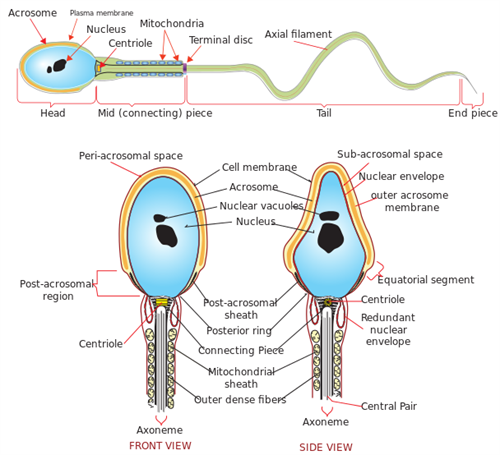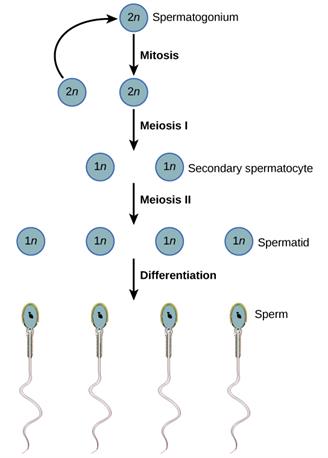
PUMPA - SMART LEARNING
எங்கள் ஆசிரியர்களுடன் 1-ஆன்-1 ஆலோசனை நேரத்தைப் பெறுங்கள். டாப்பர் ஆவதற்கு நாங்கள் பயிற்சி அளிப்போம்
Book Free DemoIn this section, we shall study the pre-fertilisation events, gametogenesis and gamete transfer.
Gametogenesis is the process of the formation of gametes or sex cells, i.e., sperm in males and ovum in females.
Spermatogenesis:
The sperms are produced in the seminiferous tubule present in the testis (male reproductive organ). This process is called spermatogenesis.
Let us now study the structure of the sperm or spermatozoa. Each sperm is a cell of length \(50\)\(m\). The spermatozoa consist of:
1. Head
2. Middle piece
3. Tail

Structure of a sperm
The head of the sperm is elongated and is formed by the condensation of the nucleus. It also contains the male's genetic information that is to be passed on to the next generation. The anterior portion of the sperm contains a protective cap-like structure called an acrosome at the tip.
The acrosome secretes hyaluronidase, a lytic enzyme that helps break down the egg's wall for fertilisation. It helps the sperm to enter the ovum during the process of fertilisation.
A short neck connects the middle piece and the head. It comprises centrioles. The middle piece contains mitochondria that provide energy for the tail's movement, and brings about sperm motility essential for fertilisation.
The sperm has a long tail, which helps the sperm in swimming inside the female reproductive tract. This facilitates the sperm to reach the egg.
A video displaying the parts of sperm:
The sperm is produced from its precursor, the spermatogonium. Spermatogonium first divides mitotically to produce the diploid spermatocytes.
Spermatocytes undergo meiosis to produce four haploid spermatids that are immature sperms. The spermatids undergo maturation and differentiation in the epididymis to develop into sperm.

The process of spermatogenesis
Reference:
https://commons.wikimedia.org/wiki/File:Complete_diagram_of_a_human_spermatozoa_en.svg
https://www.youtube.com/watch?v=sOVpgmxBiqY&t=8s
https://upload.wikimedia.org/wikipedia/commons/f/f1/Figure_43_03_05.jpg